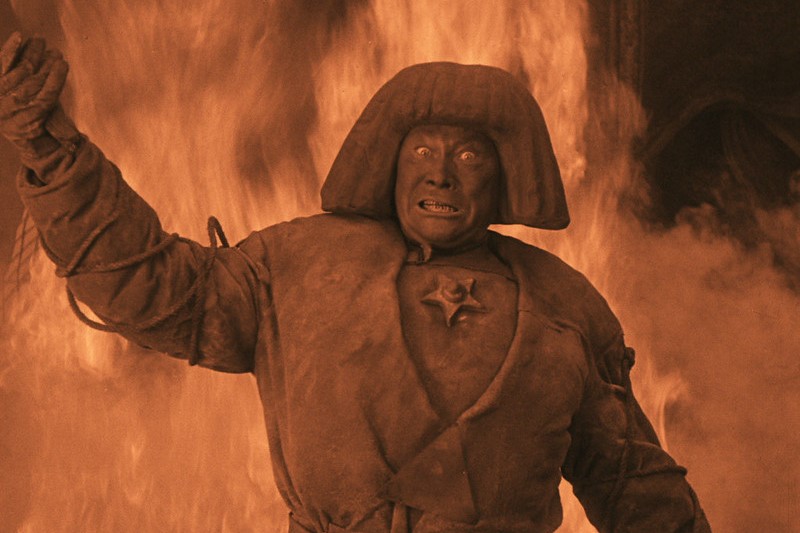Der Golem, wie er in die Welt kam has a good claim to being the first film prequel. Writer, star and co-director Paul Wegener was fascinated by the legend of the Golem and had already made two films featuring the creature. Both 1915’s Der Golem and The Golem and the Dancing Girl from 1917 were set in the contemporary era, and are now lost to time. This surviving film is a classic of silent cinema and one of the three great horror films of the Weimar period, along with The Cabinet of Dr. Caligari and Nosferatu. Even if it shows Wegener’s understanding of Jewish legend and ritual to be somewhat limited, it’s still both a technical ground-breaker and an expressive delight.
In 16th century Prague, Rabbi Loew (Albert Steinrück) creates a clay figure to protect the Jews of the Prague ghetto following a decree from the Emperor that they are all to be expelled from the city. He receives a magic word from the demon Astaroth which brings the Golem to life when an amulet containing the incantation is placed into its chest. Like innumerable myths from Prometheus onward however, there are consequences to men acting like gods.
Wegener’s Golem may not be one of the iconic movie monsters, but it’s impossible not to see echoes of his lumbering, misunderstood creation in Boris Karloff‘s depiction of Frankenstein’s monster eleven years later. There is the same lurching stride, the same innate pathos, and a yearning for a hidden humanity denied to them by their creator. The two films also share ace cinematographer Karl Freund, who also worked on Fritz Lang‘s Metropolis, before emigrating to the US to become Universal Studio’s DP of choice for their burgeoning horror roster. Freund’s work here is wonderful, making full use of the angular, expressionistic sets to provide the gorgeous chiaroscuro effects that characterise the period and remain beloved to this day. The limitations of a permanently static camera are overcome by measured, intuitive editing. The in-camera transformation of the Golem from inert sculpture to living being is a minor masterpiece in itself.
If The Golem falls down it’s in the fact that, even by the standards of the time, it simply isn’t remotely frightening. It lacks the chills generated by the horrifying appearance of Max Shreck‘s indelible Count Orlock in Nosferatu, or the the uncanny movements of Conrad Veidt‘s murderous somnambulist Cesare in Caligari. It’s been suggested that it’s more in-keeping with the traditions of German Romanticism than the new, more pessimistic expressionism; more Mereau then Murnau. This may be why The Golem isn’t quite as revered as its contemporaries in the pantheon of great horror cinema. There is also the issue of Wegener’s depiction of Jewish culture, not least in presenting Loew as the sinister summoner of demons. It’s likely however, that Wegener was just heedless of cultural sensitivities rather than actively anti-semitic. The portrayal of the Christian aristocracy isn’t exactly favourable and Loew’s actions are obviously for the benefit of his oppressed people. It’s true that Wegener was an ‘Actor of the State’ under the Nazi regime and appeared in several propaganda films. However, it’s likely this was down to career pragmatism, as he also donated to resistance movements and hid vulnerable people in his apartment. Still, there is still the odd uncomfortable moment as the poverty-stricken Jewish populace loom balefully from the shadows.
As with many restorations of silent films, the picture quality is occasionally patchy, with some inconsistency with the colour tinting within scenes. This is down to this new version being rather cut-and-shut from the fragments of three or four copies, as no complete original print survives. It’s astonishing that the result is as seamless as it is, although no surprise given the quality of the work that’s gone into other transfers by Murnau Stiftung, such as Sunrise and Der müde Tod.
On Blu-ray Mon 18 Nov 2019
